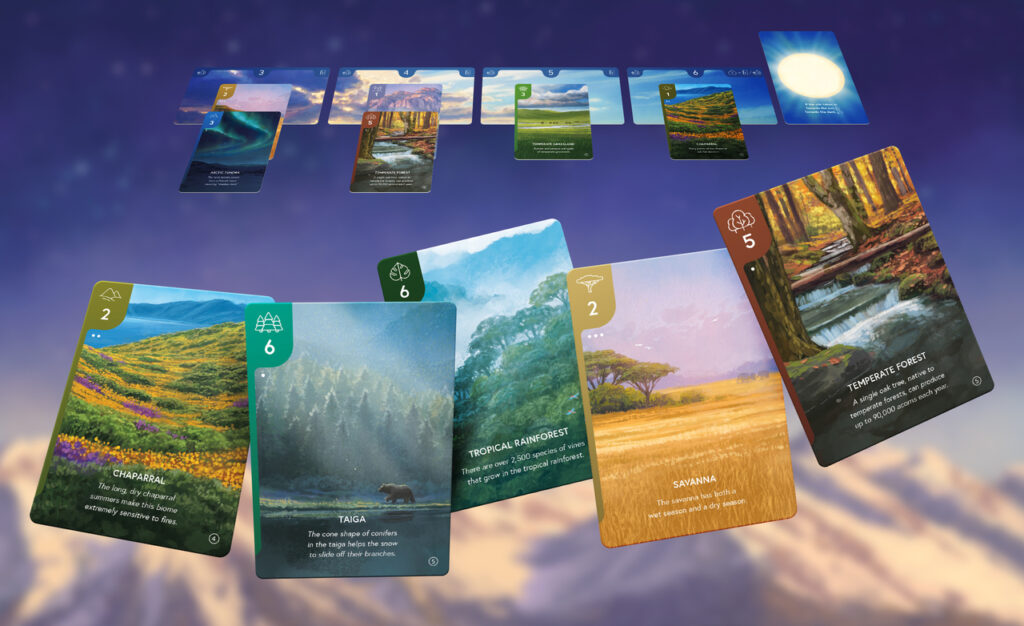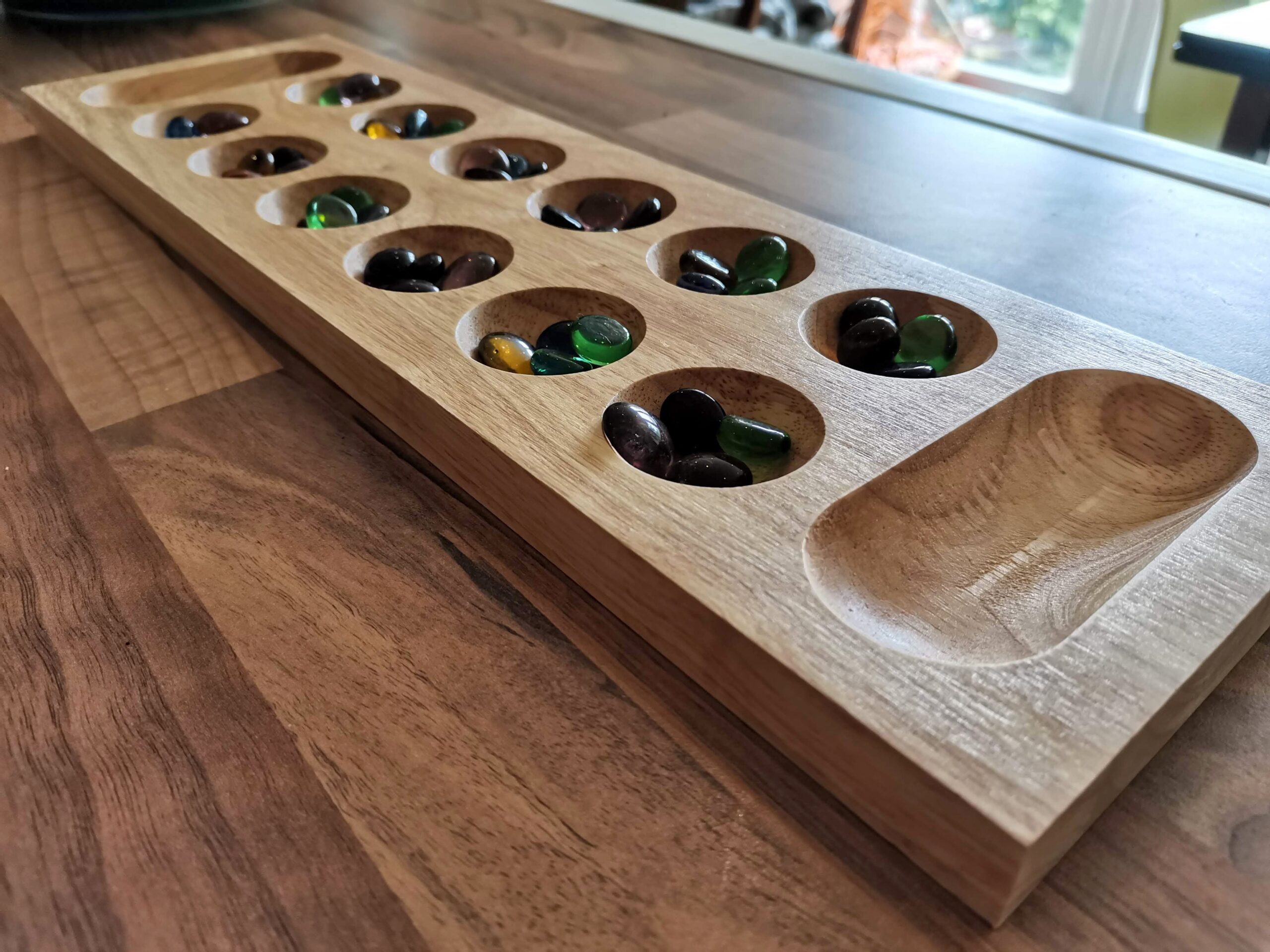Subastral Review

Subastral is a card game from the minds of Ben Pinchback and Matt Riddle, a game-design duo who collectively brought us Fleet: The Dice Game, Piepmatz, and the upcoming Three Sisters, among others. They know a thing or two about putting a good game together. This time, along with the well-oiled cogs and gears of the machinery, the outrageously talented Beth Sobel has been brought in to elevate the game with her beautiful artwork.
When I first saw the name ‘Subastral’, I immediately thought “Cool, definitely a space game”. I was wrong. Subastral in this context refers to exactly what it describes – below the stars. The focus is our own blue marble, our own speck of beauty on the canvas of cosmic insignificance: planet Earth. It’s a set-collection game, where players are trying to collect cards which represent eight of the planet’s biomes. A nice distinction from many set-collection games, is that in Subastral you’re simultaneously collecting matching and non-matching sets.
Location, location, location
It seems only fitting, that in a game that revolves around the various locations on our planet, locations play an important part in the mechanisms of the game itself. Each player has a hand of cards and a space in front of them, where they’ll create their Journal, which is a place to display your played cards. In the middle of the table lies a long set of cloud cards, numbered from one to six. These clouds are where piles of cards are added to, and taken from.
Explaining how to take your turn in Subastral is really easy, but learning what to do with your turns is another matter. More on that later, though. On your turn you play a card from your hand onto one of the clouds, then pick up any one pile from any cloud to the left or right. Here’s where the mental gymnastics start though, because if you pick up from the left of your played card, you take those cards into your hand. If you pick up from the right, those cards have to be played to the journal space in front of you, either starting new sets of biomes, or adding to existing ones.

Now you know the basics of how to play Subastral. Except that I didn’t tell you about scoring did I? Scoring in Subastral is simple in principle, but my oh my, how it’s going to break your brain trying to choose what to do.
Journalism
Adding cards to your journal is an agonising decision. Agonising in a good way though. At least, I think so. To get an idea of what I’m talking about, I’ll have to take you on a whistlestop tour of Subastral’s scoring.
Every time you add cards to your journal, you check their biomes. If it’s a biome you already have cards of, you just stack those below the existing, matching cards. If it’s one you don’t have, you add it to the end of your row of biomes. As you play, you’ll end up with more cards in some columns than others, and have anything up to eight columns of cards. The table ends up looking like pretty bar charts in some kind of landscape photographers’ AGM Powerpoint presentation.
When the game comes to an end, you check which two columns have the most cards. You multiply the number of cards by the number of the column that they’re in, and there are some points for you. Well done. That’s your matching sets coming to fruition. Now you need to look across horizontally and see how many cards are in each unbroken row. That first row might have eight cards in it, but if the second row only has a card in the first column, and then a gap, you’re only scoring a single point for that row. Sorry buster.

Once you understand these principles, you quickly realise that Subastral is a calculated game of risk and reward. It’s a darn good one too.
Pushing your luck
Regular readers know that I love push-your-luck in games. Subastral gives me that same sort of hit, but with a layer of subtlety. A bit like a velvet-covered cricket ball. Each card has a number of pips on it to give you an idea of how many cards of that type are in the deck, so you need to decide whether it’s worth trying to collect them. You also need to decide how many different kinds of biome you’re going to collect, too. Having eight in each row is worth some serious points, but if you break any of those rows, all of the cards to the right of that break are worth nothing.
Collecting matching sets gives you the same sort of wonderful headaches too. The further along your journal your biggest matching sets are, the more points each card is worth. If you can start collecting cards that match your eighth biome, each card is worth eight points. Compare that to scoring one apiece for the first column, and you can see the value in doing it.
Both of these considerations are forced on you with unsympathetic haste, because sat on the end of the row of pretty clouds, is a rapidly dwindling draw deck. When the cards are gone, they’re gone. Reining-in your plans and scoring optimally is a really tricky task, but so satisfying when it all comes together late in the game.
Final thoughts
Subastral is great. I’ve enjoyed it at two, three, and four players, and although two-player games feel like a duel, it’s a game I’ll happily pull out for any of those counts. I do have to issue a word of warning, however. The first game can be a really disconnected experience, because it’s difficult to explain how the scoring works. It takes at least one game to even understand why you want to add cards to your hand, or which pile you want to add to your journal. Be prepared for people to say “I’m going to do this, but I’m not really sure why”. Some people are going to get turned-off right away.
If you can get over that initial hurdle, there’s a very clever, very tight game waiting for you. I found the best way to start teaching is to show a completed journal, explain the scoring on show, and then explain how to play. Ben and Matt seem to have this magic touch when it comes to balancing games, and it’s present again in Subastral. There’s just enough player interaction to keep things spicy, without it becoming vindictive.
It’s not a game that’s going to set the world on fire, or go racing up the BGG hotness, but combining the work of Messrs Pinchback & Riddle with Beth’s beautiful card art has created a really good, really enjoyable game. If set-collection is your thing, or you like a card game with a bit of something different, throwing your £20 at Subastral would be a good choice.
Review copy kindly provided by Renegade Game Studios. Thoughts and opinions are my own.

Subastral (2021)
Designers: Ben Pinchback, Matt Riddle
Publisher: Renegade Game Studios
Art: Beth Sobel
Players: 2-5
Playing time: 15-30 mins











